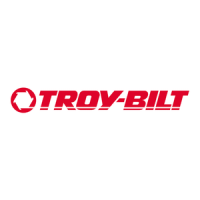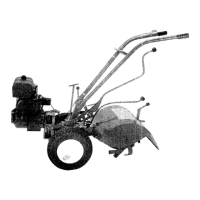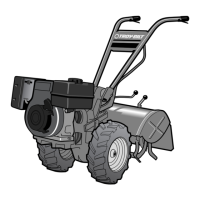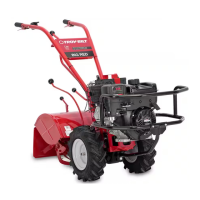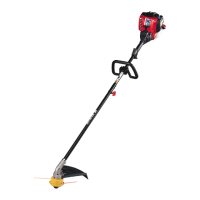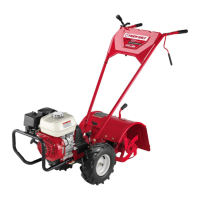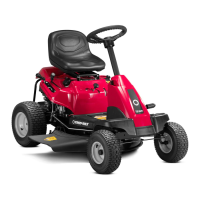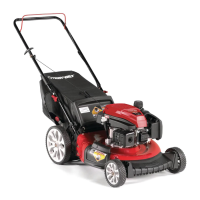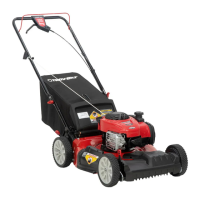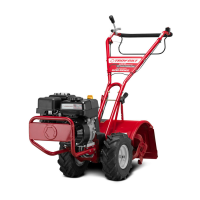You will note
that
as
you shift the lever
into
Re'{erse, the engine mount comes down
to
press
on the Reverse Adjustment
'Bolt-see
Photo
2/15. This action compresses the Reverse
Spring and Plunger Assembly, requiring you
to
hold .the Forward/Reverse Lever
up
in Re-
verse. When you let
go
of
the lever, the spring
automatically pushes the lever back into neu-
tral position and all tiller motion ceases. The
engin!=!,
of course, will continue to run. Because
the Forward/Reverse
Lever is in Neutral, the
upper (engine) pulley and the belts will turn,
but
will not power the
tiller
in either Qirection.
(Photo 2/16) Alternate
shift
method.
Automatic, "coming-out-of-Reverse into Neu-
tral"
is
an
important safety feature for the oper-
ator's protection. Please make certain that this
safety feature is always
working
properly, and
if
it needs adjustment, refer
to
Section
7,
page
102,"Howto Adjust and Maintain Reverse." This
section gives instructions
for
proper adjustment
and testing
of
this control.
IMPORTANT: For safety's sake, it is best
to
shift into reverse in
low
wheel speed, espe-
cially if the engine throttle
is
set
to
run at high
speed. Many people never shift into reverse
while in high wheel speed. This
is
a good rule
to
follow.
To
stop
tiller
motion,
simply
move the For-
ward/Reve;se Lever into the Neutral position.
WHEEL SPEED SHIFT
LEVER-Shifting
the
Wheel Speed Shift Lever
up
or
down moves the
clutch inside the
tiller
transmission
to
the left
or
right
to
engage a high speed
or
a low speed
gear. (See Photo 2/14).
No
power is provided
to the wheels unless the
clutch
(insidethe trans-
mission) and one wheel speed gearare engaged,
AND the Forward/Reverse Lever is moved
into
eitherforward
or
reverse position.
Whenever the. Forward/Reverse Lever is
put
in
Forward
or
Reverse,
not
only
do
the
tine~
turn.-as
you can easily
see-but
the wheel and
the pinion gears are constantly
turning,
unseen
in a bath
of
oil inside the transmission. (This,
of
course, assumes that the engine is running.)
The faster
you
run
your
engine, the faster the
main drive shaft
turns
the
wheel and
tiller
gears. It
is
for
this reason,
that
we
strongly
rec-
ommend that
yo,u
always make
your
speed se-
lection and shift
your
wheel
shift
lever BEFORE
you put the Forward/Reverse Lever
into
For-
ward
or
Reverse position. Thus, when
you
shift
gears, you
won't
have the wheel gears
turning
which could
jolt
the
tiller
into
action,
or
worse,
could break a lug
off
of
theclutch.
The normal sequence
for
use
of
the
control
levers on
your
Troy-Bilt
Tiller
is explained in
Section
5,
page
51
of
this manual. Briefly, the
order
is
as
follows:
1. Adjust Depth Regulator.
2.
Put Forward/Reverse Lever in Neutral.
3.
Shift into Low gear.
4.
Startengine.
5.
Put Forward/Reverse Lever in Forward
(or Reverse)
to
startthe
tiller
motion.
If
your
tiller
is stopped in soft, tilled soil, you
can shift
wheel.
speeds by
putting
the
engine
throttle at low speed, shift the Forward/Re-
verse Lever into Forward and then maintain a
continuous pressure on
the Wheel Speed Shift
Lever in the direction
of
the selected gear. The
gear will engage automatically and the
tiller.
will move.
34
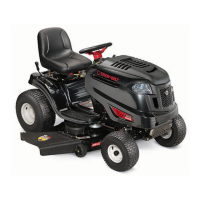
